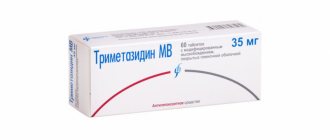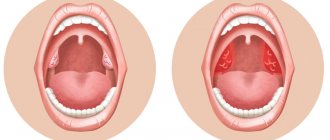Symptoms
Signs of an allergy can occur upon contact with the source of the allergy or during prolonged accumulation of the irritant in the body. The first option is most often found in children, since their immunity is not yet fully adapted to environmental influences.
Let's look at the main signs of allergies by category in the following table.
| From the outside | Manifestations |
| Respiratory organs | Dry cough or sore throat, swelling of the pharynx, difficulty breathing. Sneezing, mucus discharge from the nasal passages, nasal congestion, which can develop into chronic rhinitis, rhinosinusitis, tracheitis. |
| Circulatory system | Changes in the number of leukocytes. The appearance of hives, eczema and other skin rashes. |
| Gastrointestinal tract (allergic enteropathy) | Dehydration, upset stomach, nausea or vomiting. |
| Mucous eye | Lacrimation, allergic conjunctivitis (both primary and secondary). |
In rare cases, allergies manifest themselves in the form of loss of consciousness, anaphylactic shock, Quincke's edema, etc.
Such symptoms are not always the result of an allergy. In order to make an accurate diagnosis, consult your doctor, he will refer you for tests.
Cromoglycic acid - “non-emergency” antiallergic help
Cromoglicic acid and its derivatives stabilize mast cell membranes, preventing the opening of calcium channels and the release of calcium into mast cells. Thanks to this, the degranulation of mast cells is inhibited, which prevents the release of histamine, leukotrienes and other biologically active substances that mediate allergic inflammation.
An important aspect that concerns all cromoglycates is the slow onset of clinical effect. In this regard, it is more advisable to use them for the prevention of hay fever, rather than for its treatment.
For allergic reactions, cromoglycic acid preparations are used in the form of nasal spray and eye drops.
Cromoglycates, as well as other new generation allergy drugs, have a strong evidence base confirming their effectiveness and high safety profile [5].
Most cromoglycic acid drugs belong to the OTC group. But there are also exceptions. Thus, some eye drops are dispensed by prescription from a doctor, therefore, when offering TN to the buyer, it is important to study the instructions and clarify which group a particular drug belongs to.
Nasal spray
can be recommended for the treatment and prevention of hay fever in adults and children over 5 years of age. The therapeutic effect develops after several days or even weeks of constant use of the drug. On average, the course of treatment lasts 4 weeks, and drug withdrawal should be carried out gradually, over another 7 days [2].
Eye drops
, like the nasal spray, exhibit a noticeable therapeutic effect only a few days after the start of use. Prescribed to relieve the symptoms of allergic conjunctivitis in adults and children over 4 years of age.
What should I warn the client about?
After the therapeutic effect is achieved, you can reduce the dose of both the nasal spray and nasal drops, using them only when in contact with allergens, such as pollen. Do not forget to talk about the need for slow withdrawal of cromoglycic acid medications.
«
Kinds
Depending on the factor that activates the body's defense reaction, allergies are classified into three types. Please note that any treatment begins with reducing contact with the allergen, and the action of the drugs is mainly aimed at eliminating symptoms.
| View | Negative reaction to | Diagnostics |
| Food | Certain foods. | Provocative tests (injection of a concentrated allergen into the blood), skin tests. |
| Respiratory | Some smells, dust or blooms. | Familiarization with family history, observation. |
| Medicinal | Medications or long-term use. | People who regularly take hormonal and antibacterial drugs are at risk. Injecting a small dose of the drug into the blood. |
It is important to find out the cause of allergies at the initial stage, since at an advanced stage secondary diseases will begin to develop (bronchial asthma, eczema, sinusitis, etc.).
Histamine and histamine receptors
Histamine is one of the most important mediators, belonging to biogenic amines and synthesized from the amino acid histidine by decarboxylation. In the human body, histamine performs a number of physiological functions and is involved in many pathobiological processes. The main depot of histamine in the body is mast cells and basophils, where it is found in the form of granules in a bound state. The largest number of mast cells are located in the skin, mucous membranes of the bronchi and intestines. Histamine realizes its activity through interaction with specific histamine receptors (HRs) located on the cells of various tissues. They belong to a large family of G protein-coupled receptors (GPCRs). A group of GPCRs are actively involved in the transmission of extracellular signals across the cell membrane by specifically recognizing and binding a variety of ligands, such as proteins, ions, neurotransmitters, and even light stimuli (photons). GPCRs are widely present in the body and are involved in many processes, both physiological and pathological, such as smell, taste, vision, cognitive functions, emotions, immune response, etc. allergies, as well as in the regulation of the activity of the cardiovascular, nervous, digestive, respiratory and other systems of the body [1]. To date, four types of GH have been described (Table 1), among which the most studied are the H1 and H2 receptors, which are distributed in both the peripheral and central nervous systems (CNS) and allow histamine to act on smooth muscles and secretory activity of the glands of the mucous membranes.
Acting on the H1 receptor, histamine causes itching, stimulates secretion of the nasal mucosa, contracts smooth muscles in the bronchi and intestines, and relaxes smooth muscles in small blood vessels. In addition, histamine stimulates the secretion of gastric acid through H2 receptors. H3 receptors are primarily expressed in the CNS and act as autoreceptors on histaminergic neurons, inhibiting histamine release and modulating other neurotransmitters. H4 receptors are found in cells of the immune system, the gastrointestinal tract, the central nervous system and primary afferent neurons. The action of histamine on H4 receptors causes chemotaxis of mast cells, secretion of cytokines and activation of adhesion molecules [7].
Predominantly H1 receptors are involved in the development of allergies, but data have now been accumulated on the role of H4 receptors in immunopathological conditions [7–10]. The possibility of using drugs that act on H4 receptors for various diseases is being discussed, incl. for allergies [11]. H2 receptors may also be involved in the development of allergic manifestations [12, 13].
The following fact is important: all GPCRs have constitutive (spontaneous) receptor activity, i.e. their activity is manifested even in the absence of the agonist and its connection with the receptor [14]. This is clearly explained by the model of the equilibrium state of the receptor: the simultaneous existence of its spontaneously active and inactive forms. Under the influence of various agents, an imbalance can occur and a shift towards activation (in the case of GH - under the influence of histamine) or, conversely, towards the inactive state of the receptor (under the influence of blockers, or rather inverse agonists of H1 receptors). In addition, there are neutral agonists that bind to both active and inactive forms of receptors, maintaining their equilibrium state. Based on the above, H1-antihistamines, in fact, are not blockers, but inverse agonists of receptors, although the usual terminology has traditionally been preserved to this day [15].
The effect of histamine on H1 receptors is represented by a wide variety of clinical manifestations:
- in the skin - swelling, hyperemia, itching, rashes;
- in the upper respiratory tract – itching, sneezing, swelling of the nasal mucosa and paranasal sinuses, increased mucus secretion;
- in the lower respiratory tract - swelling of the bronchial wall, hypersecretion and bronchospasm;
- in the mucous membrane of the eyes - itching, hyperemia, swelling and lacrimation;
- in the gastrointestinal tract - abdominal pain, vomiting, diarrhea, increased production of mucus, pepsin and hydrochloric acid;
- in the cardiovascular system - systemic arterial hypotension and cardiac arrhythmia.
Histamine plays one of the key roles in the development of allergic diseases such as atopic dermatitis, allergic rhinitis, bronchial asthma, allergic conjunctivitis, urticaria, as well as systemic anaphylactic reactions [16].
Activation of H1 receptors is accompanied by the production of phospholipase C, D and A2, which ultimately leads to the release of calcium ions (Ca2+), respectively, to the activation of cell function. In addition, the activity of nuclear factor kB (NF-kB) increases, which is associated with the production of pro-inflammatory cytokines and intercellular adhesion molecules, such as P-selectin, ICAM-1, VCAM-1, iNOS, TNF-α, GM-CSF, IL -1β, IL-6. It has been established that NF-kB plays an important role in the activation of lymphocytes, in particular, it promotes the differentiation of type 2 T helper cells (Th2 lymphocytes), which is especially important in allergic diseases. Increased levels of NF-kB are found in patients with various types of allergies, incl. with bronchial asthma [17]. Thus, H1 receptors are not only involved in the early phase of the allergic reaction, but also have broader immunological properties, incl. play an important role in the development of the late phase of allergic inflammation. Consequently, the antiallergic effect of antihistamines (AGDs) is multifaceted and includes, incl. anti-inflammatory effect [12].
Classification of antihistamines
According to the classification adopted by the European Academy of Allergists and Clinical Immunologists, all antihypertensive drugs are divided into two generations depending on their effect on the central nervous system.
First generation AGP
First-generation H1 receptor inverse agonists cross the blood-brain barrier and can both stimulate and depress the central nervous system. This typically manifests as CNS depression in most patients. A sedative effect when taking first-generation antihypertensive drugs is subjectively noted by 40–80% of patients. Its absence in individual patients does not exclude an objective negative effect of these drugs on cognitive functions, which patients may not complain about (ability to drive, learn, etc.). Dysfunction of the central nervous system is observed even when using minimal doses of these drugs. The effect of first-generation antihypertensive drugs on the central nervous system is the same as when using alcohol and sedatives [18–20]. Stimulation occurs in some patients receiving conventional doses of antihypertensives, manifesting as restlessness, nervousness, and insomnia. Typically, central excitation is characteristic of an overdose of first-generation antihypertensive drugs; it can lead to convulsions, especially in children.
In addition to the sedative effect and effect on cognitive functions, first-generation antihypertensive drugs are characterized by the following properties:
- short-term effect (forced use 3-4 times a day);
- rapid development of tachyphylaxis (it is necessary to change the drug every 7–10 days);
- low selectivity of action: in addition to H1 receptors, they block acetylcholine, adrenaline, serotonin, dopamine receptors and ion channels, causing many side effects: tachycardia, dry mucous membranes, increased sputum viscosity.
First-generation antihypertensives can increase intraocular pressure, interfere with urination, cause stomach pain, constipation, nausea, vomiting, and increase body weight [21]. That is why these drugs have a number of serious restrictions for use among patients with glaucoma, cardiovascular pathology, diseases of the genitourinary system, etc.
In acute poisoning with first-generation H1-AGPs, their central effects are the most dangerous: the syndrome includes hallucinations, agitation, ataxia, incoordination, convulsions, etc. Fixed dilated pupils on a flushed face along with sinus tachycardia, urinary retention, dry mouth and fever very similar to signs of atropine poisoning. In children with an overdose of first-generation antihypertensive drugs, agitation and convulsions may occur. Therefore, experts in many countries are calling for the abandonment of this group of drugs for children or their use under strict supervision. In addition, sedation may impair children's learning and performance at school [22].
Second generation AGP
New antihypertensive drugs (second generation), unlike old drugs, first generation antihypertensive drugs, are distinguished by a selective effect on H1 receptors, almost do not penetrate the blood-brain barrier, which reduces the likelihood of developing a sedative effect when using them, so they can be recommended to drivers, people, work which requires concentration, for schoolchildren and students. The second generation of antihypertensive drugs is characterized by a higher affinity for H1 receptors, accordingly, the rapid development of the clinical effect and a longer action (over 24 hours) compared to the first generation drugs, which allows the use of most of them no more than once a day. Second-generation antihypertensive drugs are characterized by a low likelihood of developing tolerance to the drug (no tachyphylaxis), and they have a more favorable safety profile.
Second-generation H1-AGPs (H1 receptor inverse agonists) are currently considered the drug of choice for allergic rhinitis, urticaria, and other pruritic dermatoses [16, 23–25].
Side effects of AGP
Side effects of antihypertensive drugs include anticholinergic effects (dry mouth, sinus tachycardia, constipation, urinary retention, blurred vision), adrenolytic effects (hypotension, reflex tachycardia, anxiety), antiserotonin (increased appetite), central antihistamine effects (sedation, increased appetite), blockade potassium channels in the heart (ventricular arrhythmia, prolongation of the GT interval) [26]. The selectivity of the action of drugs on target receptors and the ability to penetrate the blood-brain barrier determine their effectiveness and safety [27].
Among second-generation antihypertensive drugs, cetirizine and levocetirizine have the lowest affinity for M-cholinergic receptors, and therefore an almost complete absence of anticholinergic action (Table 3) [28].
Some antihypertensive drugs can cause the development of arrhythmias up to life-threatening forms. Terfenadine and astemizole are “potentially cardiotoxic.” Due to the ability to cause a potentially fatal arrhythmia - flutter-fibrillation (metabolic impairment due to liver disease or against the background of CYP3A4 inhibitors), terfenadine and astemizole are prohibited for use in many countries, including. and in Russia, from 1998 and 1999. respectively. There are cautions regarding the cardiotoxicity of webastine and rupatadine with regard to currently existing antihypertensive drugs. They are not recommended for use in persons with a prolonged QT interval or hypokalemia. Cardiotoxicity increases when taken simultaneously with drugs that prolong the QT interval: macrolides, antifungals, calcium channel blockers, antidepressants, fluoroquinolones.
Many antihypertensive drugs are metabolized in the liver with the participation of cytochrome P450, and therefore their simultaneous use with inhibitors of this enzyme is not recommended: a number of antifungal drugs (itraconazole, ketoconazole), many macrolides, some antidepressants, cimetidine, etc. [12]. Cetirizine and levocetirizine are not subject to hepatic metabolism [29], fexofenadine is minimally metabolized [30].
According to US toxicological services, first-generation antihypertensive drugs cause 8.3% of deaths from overdose poisoning among adults. In addition, a number of studies indicate that not only diphenhydramine, but also other first-generation AGPs (dextromethorphan, doxylamine, chlorpheniramine, etc.), common in the United States, were found in children, mainly under 12 years of age, who died from various causes, possibly related to overdose of first-generation antihypertensive drugs [31, 32].
Use of antihypertensive drugs in children
The main indication for prescribing antihypertensive drugs to children is the elimination of allergic symptoms associated with the release of histamine, such as itching, sneezing, rhinorrhea and nasal congestion. Second-generation H1 receptor inverse agonists with no or little sedative effect are preferred [33]. It has been shown that the use of second-generation antihypertensive drugs by children with allergic rhinitis does not lead to a decrease in their school performance [34].
The main route of administration is oral, while the parenteral route, possible only for some first-generation antihypertensive drugs (clemastine, chloropyramine), is used to relieve acute allergic reactions (urticaria, angioedema) or for premedication before diagnostic and surgical interventions [16]. External use of topical forms for intranasal, intraconjunctival and cutaneous use of the first generation AGP (Table 4) is intended to eliminate allergy symptoms in eye diseases, rhinitis, and skin itching [33].
Of no small importance in pediatric practice are the availability of special children's dosage forms and the age-permitted range of drug use. Currently in Russia, not a single second-generation antihypertensive is approved for use by children under 6 months. In this age category, the doctor can only prescribe dimethindene and chloropyramine (from the 1st month), while only dimethindene has a pediatric oral dosage form (drops). Of the other drugs used at older ages and having pediatric dosage forms, currently only cetirizine is approved for use by children from 6 months (oral drops, use by children from 6 to 12 months is possible only as prescribed by a doctor under strict medical supervision).
In table 5 discusses the indications for the use of antihypertensive drugs.
Cetirizine
Cetirizine occupies a special place among second-generation AGPs. Along with all the advantages of non-sedating antihypertensive drugs, cetirizine demonstrates properties that distinguish it from a number of new generation drugs, ensuring its high clinical efficacy and safety [46, 47]. In particular, it is characterized by additional antiallergic activity, a rapid onset of effect, and there is no risk of interaction with other medicinal substances and food, which opens up the possibility of safe administration of the drug to patients with concomitant diseases.
The effect of cetirizine consists of its influence on both phases of allergic inflammation. The antiallergic effect includes the so-called. extra-H1 receptor action: inhibition of the release of leukotrienes, prostaglandins in the nasal mucosa, skin, bronchi, stabilization of mast cell membranes, inhibition of eosinophil migration and platelet aggregation, suppression of ICAM-1 expression by epithelial cells [48, 49].
Many authors, both foreign and domestic, consider cetirizine to be the standard of modern AGP. It is one of the most studied antihypertensive drugs, having proven its effectiveness and safety in many clinical studies. For patients who respond poorly to other antihypertensive drugs, cetirizine is recommended [50]. It fully complies with the requirements for modern AGP.
Cetirizine is characterized by a half-life of 7–11 hours, the duration of the effect is 24 hours, after a course of treatment the effect lasts up to 3 days, with long-term use (up to 110 weeks) the development of tolerance is not observed. The duration of the effect of cetirizine (24 hours) is explained by the fact that the effect of AGP is determined not only by the concentration in plasma, but also by the degree of binding to plasma proteins and receptors. Binding to receptors for 24 hours for cetirizine is about 60%, which exceeds this parameter for other AGPs.
Cetirizine is practically not metabolized in the liver and is excreted primarily by the kidneys, so it can be used even by patients with impaired liver function; for patients with renal failure, a dose adjustment of the drug is required.
One of the most important aspects of the drug’s action is the speed of onset of the effect (Table 6). Among second-generation AGPs, the shortest TCmax (time to reach maximum concentration) was observed for cetirizine and levocetirizine. It should be noted that the antihistamine effect begins to develop much earlier and is minimal in antihistamines that do not require preliminary activation in the liver, for example, in cetirizine - after 20 minutes. The maximum concentration of cetirizine is achieved after 1±0.5 hours from administration, in contrast, for example, to loratadine/desloratadine, for which Tmax≈3 hours. Food reduces the overall rate, but does not affect the complete absorption of cetirizine. The long half-life (T½=10 hours) allows the drug to be used once a day. In childhood, the half-life is shortened: from 6 months to 2 years – 3.1 hours; from 2 to 6 years – 5 hours; from 6 to 12 years – 6 hours, which requires changing the dosage regimen in children in accordance with age-related pharmacodynamics: it is advisable to divide the daily dose into 2 doses in order to maintain an optimal high concentration of the drug in the body [51].
On the pharmaceutical market of the Russian Federation, cetirizine preparations, in addition to the original (Zirtec), are currently registered with more than a dozen generic drugs from different manufacturers (RLS, 2020). However, not all generic cetirizines have therapeutic efficacy and safety comparable to the original molecule, proven in clinical studies. A comparative study of cetirizine drops showed that Zodak is comparable in therapeutic efficacy, tolerability and safety to the original drug Zyrtec in relieving the symptoms of seasonal allergic rhinitis in children [52].
Conclusion
H1-AGPs are often used in pediatric practice for the treatment of allergic diseases in accordance with the principles of evidence-based medicine, while their off-label use gives conflicting results (Table 5). The effectiveness of second-generation antihypertensive drugs has been well studied, and they are preferable for use in pediatric practice when side effects need to be minimized. Pharmacological characteristics of cetirizine - rapid onset and duration of action, high specificity for H1 receptors, impact not only on the early but also on the late phase of an immediate allergic reaction, effectiveness, safety and the possibility of long-term use, confirmed in numerous clinical studies, as well as the presence convenient droplet form, approved for use in infants from 6 months, make it a suitable drug for the treatment and prevention of various allergic diseases in children.
Antihistamines
Histamine plays one of the main roles in the functioning of the body. It is this that provokes the occurrence of an allergic reaction. There are four categories of histamine receptors located in the human body. The first type is located in the blood vessels, brain and intestinal smooth muscles, the second - in the stomach tissues, cartilage and cardiac tissues, the third - in the central nervous system and the fourth - in the spleen, intestinal tissues, and bone marrow.
There are first and second generation antihistamines. The first group has a rapid effect, blocking the first type of receptors. But it negatively affects the condition of organs and systems, causes drowsiness and impaired coordination. In addition, the effect of such funds is short-term. The second group produces long-lasting results and does not cause sedation. Such drugs only negatively affect the functioning of the heart. There are also new generation products, the level of negative impact of which is reduced to a minimum.
The doctor determines which group of drugs should be used. For your information, we provide you with a list of the best allergy remedies.
| Name | Generation | Main component | Release form | pros |
| Suprastin | First | Chloropyramine | Tablets and solution for injection. | Effective for acute allergic reactions. Allowed for children under one year of age. Low cost. |
| Tavegil | First | Clemastine | Pills. | Allowed for one year old children. Rarely causes drowsiness. |
| Diphenhydramine | First | Diphenhydramine | Tablets and solution for injection. | Allowed for one year old children. |
| Fenistil | Second | Dimetinden | Drops, gel. | Can be used by children from one month of age. Eliminates itching, burns, irritation. |
| Loratadine | Second | Loratadine | Pills. | Does not cause drowsiness, has a mild antiallergic effect. |
| Claridol | Second | Loratadine | Tablets, syrup. | The effect of the product begins after 8 hours and lasts for at least a day. The drug does not cause side effects. Allowed for children from two years of age. |
| LauraHexal | Second | Loratadine | Pills. | A high-quality drug, approved for children from two years of age. Does not cause side effects. |
| Tsetrin | Third | Cetirizine | Tablets and syrup. | Tablets are allowed for children from six years of age, syrup - from two years of age. The drug lasts for more than a day and is not addictive. The effect lasts longer than three days, even after stopping the drug. |
| Suprastinex | Third | Levocetirizine | Tablets and drops. | In the form of drops, it is allowed for children from two years of age. This is a powerful drug that has anti-allergic and anti-inflammatory effects. Eliminates signs of urticaria, conjunctivitis, rhinitis, allergic atopic dermatitis. |
| Telfast | Third | Fexofenadine | Pills. | Improved form of Suprastinex (acts faster). |
| Erius | Desloratadine | Tablets and syrup. | In the form of syrup, it is allowed for one-year-old children. The effect of the drug begins within half an hour. Does not cause drowsiness. Valid for more than a day. |
To reduce the negative impact of drugs, it is recommended to use enterosorbents, the action of which is aimed at removing toxins from the body. Pay attention to Enterosgel, which is available in the form of a paste for internal use.
Drugs are usually divided into two groups:
- 1st generation antihistamines
- 2nd generation antihistamines
1st generation antihistamines were developed back in the 40s. Since then, many drugs in this group have been tested. The most popular in Russia:
- Chlorphenamine;
- Chloropyramine (Suprastin);
- Dimetinden (Fenistil);
- Diphenhydramine (Diphenhydramine);
- Clemastine (Tavegil);
- Mebhydrolin (Diazolin);
The problem with 1st generation antihistamines is that their non-selective action can cause sedation and side effects:
- increased intraocular pressure;
- increased heart rate;
- deterioration of the gastrointestinal tract;
- dry mouth;
- drowsiness;
- slowing down the reaction.
Because of this, it is undesirable to use drugs in elderly people and patients with problems of the gastrointestinal tract, cardiovascular system, prostate gland and bronchial asthma. In other categories of people, it may not be advisable to increase the dose of the drug during treatment. Also, the drugs are characterized by a short antihistamine effect (up to 3-5 hours) and therefore they must be taken 3-4 times a day. Their use is not recommended for a long time, because... may be addictive.
15 years later, antihistamines were created that act selectively on H1 receptors. They no longer have a sedative effect. This category of drugs is usually called 2nd generation antihistamines.
Sprays and drops
Since the treatment must be comprehensive, a nasal spray acts as an additional antiallergic agent. After reading customer reviews, we have compiled a rating of the TOP 3 remedies against allergic rhinitis.
| Name | Type of drug | pros |
| Tizin Alerji | Vasoconstrictor | Fast action, long lasting results, no side effects. A small single dose is required, so the drug is economical. Approved for use by children and pregnant women. |
| Avamis (adults only) | Hormone | Reduces the inflammatory effect, lasts for at least eight hours. |
| Allergodil | Antihistamine | Does not contain hormonal substances. The drug can be used as a prophylaxis. |
To eliminate itching and watery eyes, as well as conjunctivitis, special drops are prescribed. Let's look at the best products, according to buyers.
| Name | Type of drug | pros |
| Visine | Vasoconstrictor | Quickly relieves swelling and inflammation, allowed for children from two years of age. |
| Allomide | Antihistamine | Blocks the first type of receptors. The drug is used in the treatment of conjunctivitis, as well as as a prophylaxis. |
| Diclofenac | Non-steroidal | The drug relieves inflammation and has an analgesic effect. Eliminates lacrimation. |









